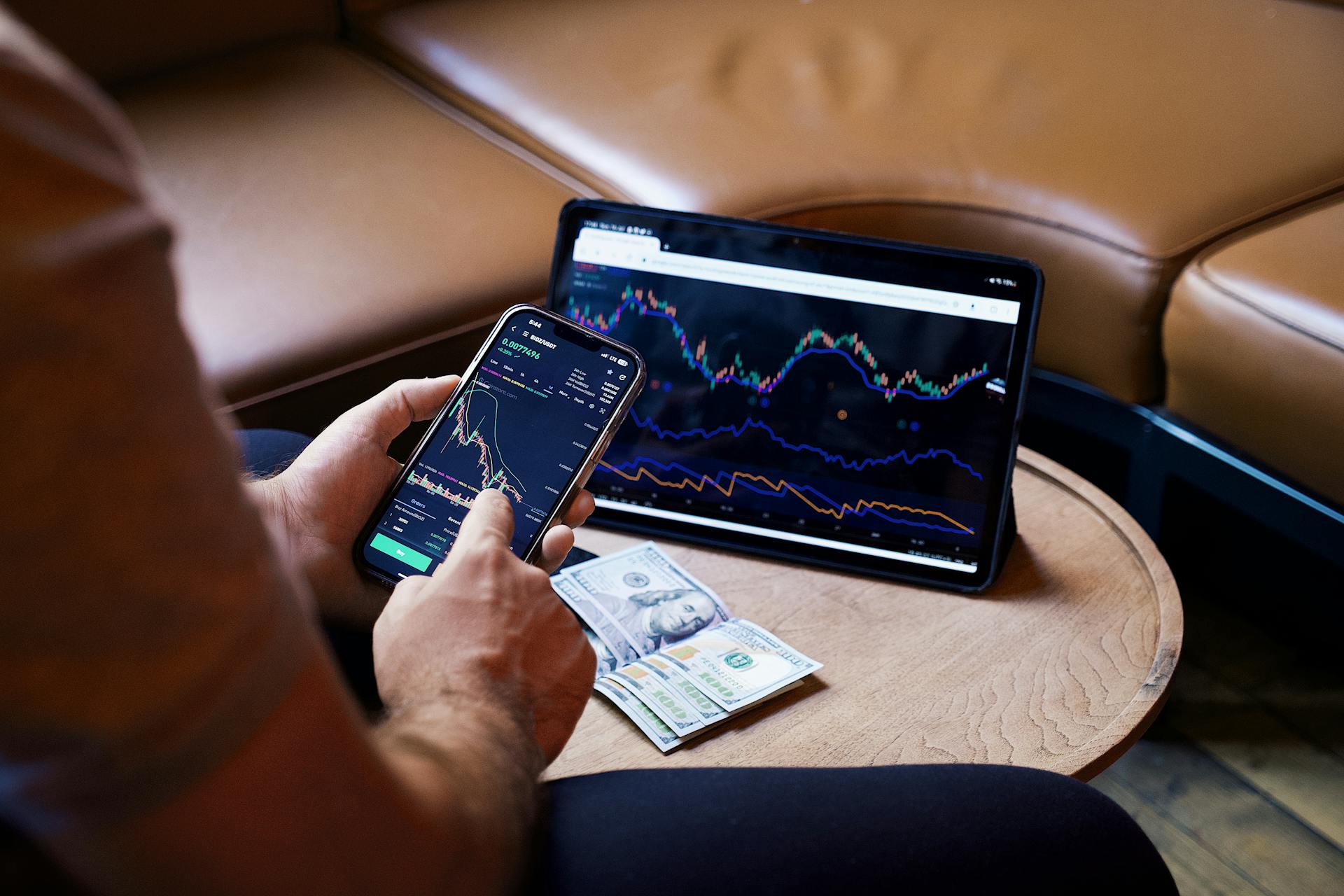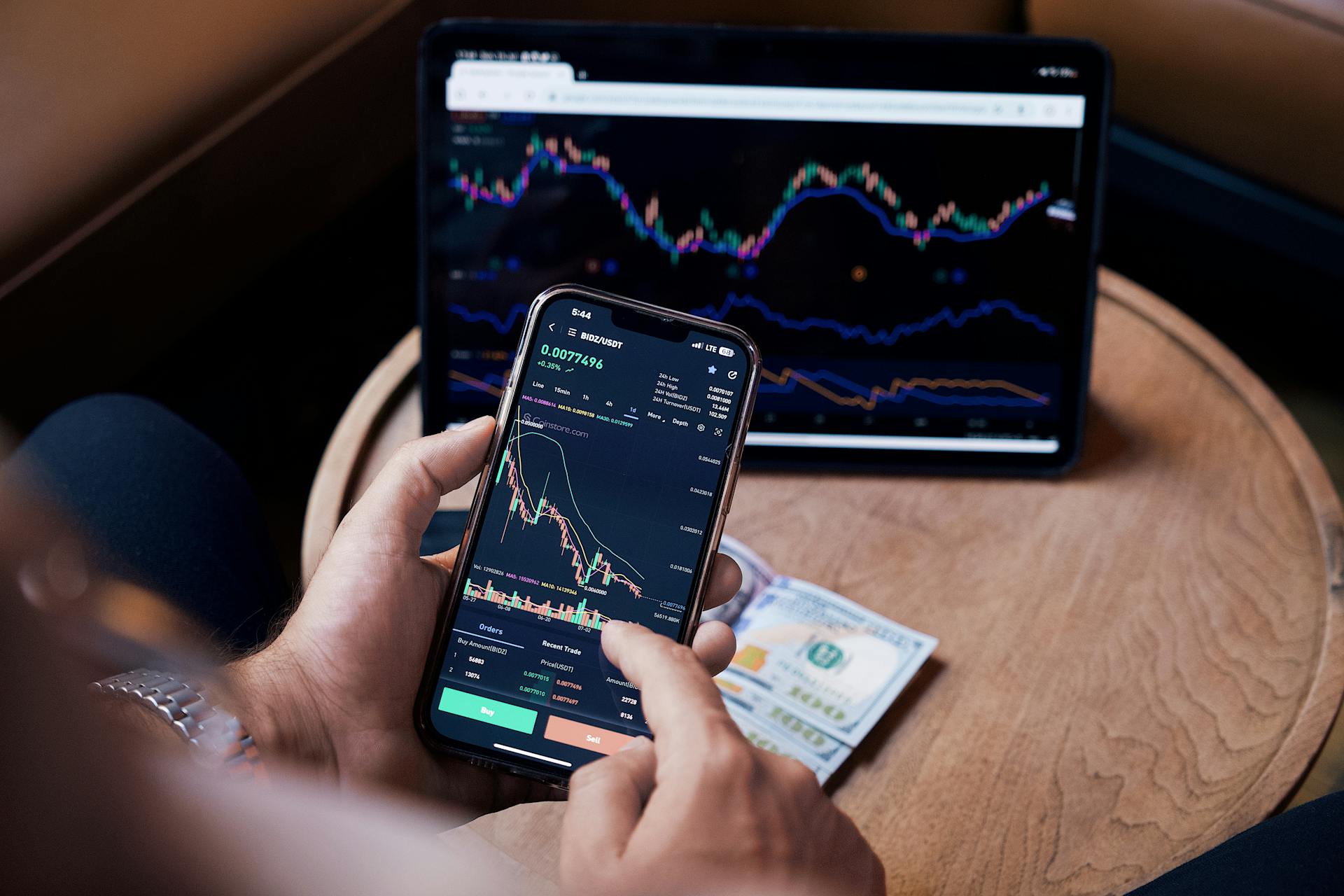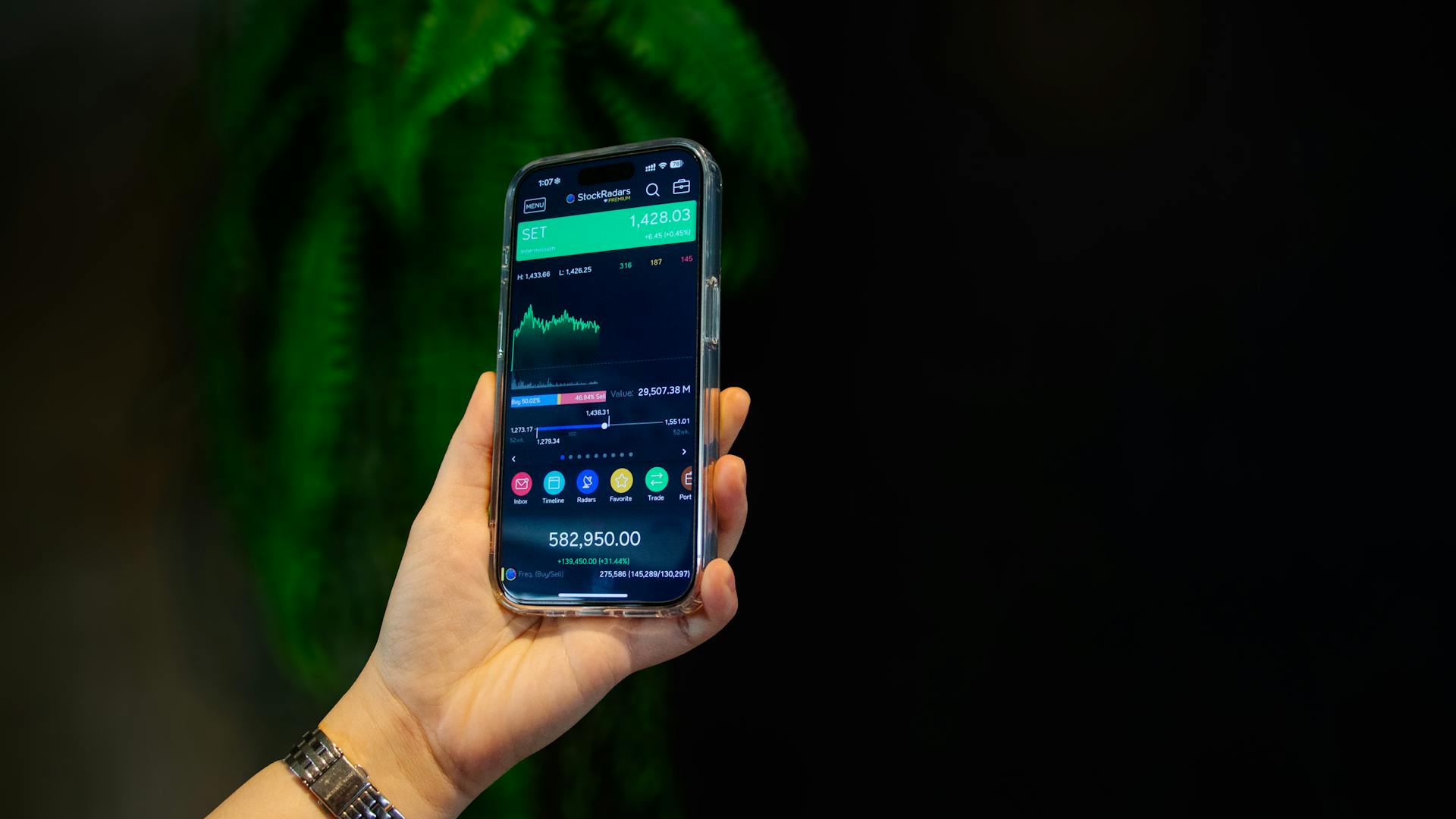
After-hours trading can be a great way to react to unexpected news or events that happen outside of regular market hours.
The regular trading hours in the US are from 9:30am to 4:00pm ET, but after-hours trading allows you to buy and sell stocks from 4:00pm to 8:00pm ET.
This extended trading period can be especially useful for traders who can't participate in regular trading hours due to work or other commitments.
After-hours trading is also known as extended hours trading, and it's available on most major stock exchanges, including the NYSE and NASDAQ.
What Is After Hours Trading
After hours trading is a type of trading that takes place outside of regular market hours, typically between 4:00 PM and 8:00 PM ET.
This extended trading session allows investors to react to news and events that occurred during the day, but weren't reflected in the closing prices.
The after hours trading session is usually less liquid than regular trading hours, which can result in wider bid-ask spreads.
Investors should be aware that after hours trading can be more volatile than regular trading hours, with prices potentially fluctuating rapidly.
Some brokerages offer extended trading hours, but these sessions may have different rules and regulations than regular trading hours.
Investors should carefully review their brokerage's policies before engaging in after hours trading.
A unique perspective: How Are Stock Speculators Different from Stock Investors
How It Works
After-hours trading is an extension of regular trading hours, allowing investors and traders to buy and sell financial instruments outside of official market operating hours. The exact duration of after-hours trading can vary depending on the exchange and platform.
Traders can participate in after-hours trading through specialized trading platforms or brokerage accounts that support pre-market orders. These platforms often have extended hours sessions, such as tastytrade's 1.5 hours before the open and four hours after the market closes.
During after-hours trading, prices are determined by the interaction of buy and sell orders, similar to regular trading hours. However, due to lower trading volume, bid-ask spreads can be wider, and price movements may be more volatile.
Take a look at this: Forum for Stock Traders

Here are some key characteristics of after-hours trading:
- Time Period: After-hours trading occurs after the official market closing time and extends for a few hours.
- Participation: After-hours trading is available to institutional investors, retail traders with access to pre-market trading platforms, and market makers.
- Eligible Securities: Stocks with significant trading volumes and liquidity are more likely to be available for after-hours trading.
- Price Discovery: Prices are determined by the interactions of buyers and sellers during after-hours trading.
- Order Types: Traders can use various order types, including market, limit, and stop-loss orders.
Overall, after-hours trading provides flexibility, but it also carries higher risks and less liquidity, so investors should proceed with caution.
How to
To start trading after hours, you'll need to log into your brokerage account and place orders for the stocks you want to buy. The process is relatively the same as trading during normal hours.
Trading after hours is done through electronic communication networks (ECNs), which can have significant limits and present additional risks. This means you'll need to be aware of these risks before you start trading.
To get started, you'll need to create an account or log in to your existing one. This will give you access to the ECNs and allow you to place trades.
Here are the basic steps to start trading extended hours:
- Learn about extended hours trading
- Create an account or log in
- Decide which market and asset you want to trade
- Open, monitor and close your position
If a match is found for your trade, it will be executed, and you'll be able to monitor your position. If no match is found, there will be no trade, and you'll need to try again during regular trading hours.
Curious to learn more? Check out: Zerodha Account No
When Does It Start and End?

The after-hours trading session typically begins shortly after the official market closing time. Most U.S. stock exchanges ring the closing bell at 4:00 PM Eastern Time (ET). After-hours trading can commence within minutes or shortly after the regular market closes, allowing investors and traders to continue trading beyond the official closing bell.
The exact start time of the after-hours session can vary slightly between different exchanges and trading platforms. While some platforms may begin after-hours trading immediately at 4:00 PM ET, others may start a bit later, usually within the next half-hour or so.
Here's a breakdown of the after-hours trading start times at the New York Stock Exchange and the Nasdaq Stock Market:
The after-hours trading session can extend for several hours, but the exact duration can vary depending on the exchange and platform. It typically starts shortly after the market closes and continues for several hours.
Benefits and Risks
Extended trading hours allow market participants to react to breaking news and corporate earnings reports that are released outside regular trading hours, providing an opportunity to adjust positions and capitalize on price movements driven by significant events.
Flexibility is also a key benefit, as extended hours trading provides a chance for traders with different schedules to engage in sessions outside of regular trading hours, allowing them to manage their portfolios.
Extended trading allows market participants to respond to events and developments that occur in international markets while their local markets are closed, which can be valuable for international investors.
Here are some key benefits of after-hours trading:
- React to News: Extended trading hours allow market participants to react to breaking news and corporate earnings reports.
- Flexibility: Extended hours trading provides flexibility for traders with different schedules.
- Global Trading: Extended trading allows market participants to respond to events and developments that occur in international markets.
- Opportunity for Gap Moves: Price gaps can occur between the previous day's closing price and the opening price of the next regular session.
However, extended trading also comes with some risks, including lower liquidity and higher volatility, which can make it more challenging to execute large orders without impacting prices.
Benefits of
Extended trading hours offer numerous benefits to traders and investors. One of the main advantages is the ability to react to breaking news and corporate earnings reports that are released outside regular trading hours.
This allows market participants to adjust their positions and capitalize on price movements driven by significant events. For example, if a company releases a surprise earnings report, traders can quickly respond by buying or selling the stock during extended hours.
Expand your knowledge: What Percentage of Day Traders Lose Money

Extended hours trading provides flexibility for traders with different schedules. Whether you're a busy professional or a stay-at-home parent, you can manage your portfolio during times that suit you best.
By participating in extended sessions, you can take advantage of global trading opportunities and respond to events and developments that occur in international markets while your local markets are closed.
Price gaps can occur between the previous day's closing price and the opening price of the next regular session. These gaps can be a great opportunity for traders to capture potential profits, especially if they participate in extended sessions.
Here are some of the benefits of extended trading hours in a concise list:
- React to News: Extended trading hours allow market participants to react to breaking news and corporate earnings reports.
- Flexibility: Extended hours trading provides flexibility for traders with different schedules.
- Global Trading: Extended trading allows market participants to respond to events and developments that occur in international markets.
- Opportunity for Gap Moves: Price gaps can occur between the previous day's closing price and the opening price of the next regular session.
Risks
The risks of after-hours trading are numerous and significant. Liquidity is lower during extended trading sessions, resulting in wider bid-ask spreads and making it more challenging to execute large orders without impacting prices.
Suboptimal liquidity can lead to slippage, where investors face difficulty or unfavorable pricing when entering or exiting a trade. This can result in investors receiving an inferior price for their trades.

Inexplicable gap moves can occur between extended trading sessions and regular trading sessions, posing an increased risk for market participants active during the extended sessions.
Elevated volatility is another risk associated with after-hours trading, particularly in response to news events. Rapid and unpredictable price movements can pose significant risks to traders.
Wider bid-ask spreads can also occur during extended trading sessions, making it more difficult for investors to execute trades at favorable prices.
The prices of securities traded during extended trading sessions may not reflect the prices at the end of regular market hours or upon the opening of regular market hours on the next trading day.
Pricing risk is a significant concern during after-hours trading, as investors are limited to a single ECN (Electronic Communication Network) and may not have access to the best available price.
Liquidity risk is also a major issue during after-hours trading, as there are fewer market participants and limited liquidity for most stocks. This can result in wider bid-ask spreads and an increased risk that orders won't be executed.
The following risks are associated with after-hours trading:
- Pricing risk
- Liquidity risk
- Volatility
Here are some key statistics to keep in mind:
Lower Competition

One of the benefits of after-hours trading is the potential for lower competition. Since fewer traders participate in after-hours trading, you may find it easier to execute trades without facing as much competition for shares.
This can be especially helpful for traders who are looking to buy or sell a specific stock, as they may have a better chance of getting the shares they need.
Suggestion: How Do You Trade Shares on the Stock Market
Ordering and Execution
During extended hours trading, you can only use limit orders, which guarantee the price you entered or better, but don't guarantee a fill. This applies to equities, equity options, futures, and options on futures.
You can select extended hours as your time-in-force (EXT limit) to trade during the pre-market and post-market. Options on single stocks, however, aren't open for trading outside of regular daytime hours.
Here's a quick rundown of how order behavior works during extended or overnight hours:
- Market orders expire at the end of regular market hours.
- Good-for-day (GFD) limit orders expire at the close of regular market hours or the end of the last extended-hours session.
- Good-til-canceled (GTC) limit orders remain active until executed or canceled.
- Limit orders with preset limit prices expire at the end of regular market hours or the last extended-hours session.
- Stop orders won't execute during extended or overnight hours.
- Trailing stop orders queue for the opening of regular market hours on the next trading day.
Order Types
Order types are a crucial aspect of trading, and understanding the different types can help you make informed decisions. Limit orders are the only type of order that can be entered during extended hours trading sessions, which include equities, equity options, futures, and options on futures.
For your interest: Amo Order Timing in Zerodha
Market orders, on the other hand, are not allowed during extended hours, and instead, traders must use limit orders. This is because market orders guarantee a fill, but limit orders guarantee the price you entered or better.
If you're trading ETF options, some of them continue to trade after the regular daytime session, from 3:00pm to 3:15pm, or 15-minutes after the regular trading session closes. Options on single stocks, however, are not open for trading outside of the regular daytime trading session.
To trade during extended hours, you can select extended hours as your time-in-force (TIF) to trade during the pre-market and post-market. This is known as an "EXT limit" order.
Here's a quick rundown of the order types and their behavior during extended hours:
Good-for-day (GFD) limit orders expire at the close of regular market hours, while Good-til-canceled (GTC) limit orders remain active until executed or canceled. Limit orders with preset limit prices expire at the end of regular market hours or the last extended-hours session, depending on when they were placed.
A different take: Limit Orders
Restricted Orders
Restricted orders can be a challenge, especially when it comes to after-hours trading. Your orders need to be matched with a buyer or seller at the price you set, which can be tricky.
This means that some orders can't be fully executed, leaving you with a partial fill. You'll need to re-order during regular trading hours to match the price you're willing to pay.
After-hours trading is done through ECNs, which can lead to orders not being fully matched. This can cause issues with your trades, so it's essential to understand the risks.
Explore further: How Much Money Do I Need to Start Trading Stocks
Frequently Asked Questions
Where can I see after hours stock prices?
You can view after-hours stock prices on Nasdaq.com, which posts this data from 4:15 p.m. ET to 3:30 p.m. ET of the following day.
How to see overnight trading?
Find overnight trading options by clicking the 'Exchange' tab and searching for 'Overnight' to access a comprehensive list of available US stocks and ETFs
Does Qqq trade 24 hours?
No, QQQ does not trade 24 hours. It's available for trading in the Pre-Market (4:00-9:30 a.m. ET) and the After Hours Market (4:00-8:00 p.m. ET).
Who trades the market after hours?
After-hours trading is typically dominated by individual investors, as high-net-worth investors and institutional investors like mutual funds used to be the primary participants in this type of trading. However, market makers and specialists generally do not participate in after-hours trading.
Featured Images: pexels.com


